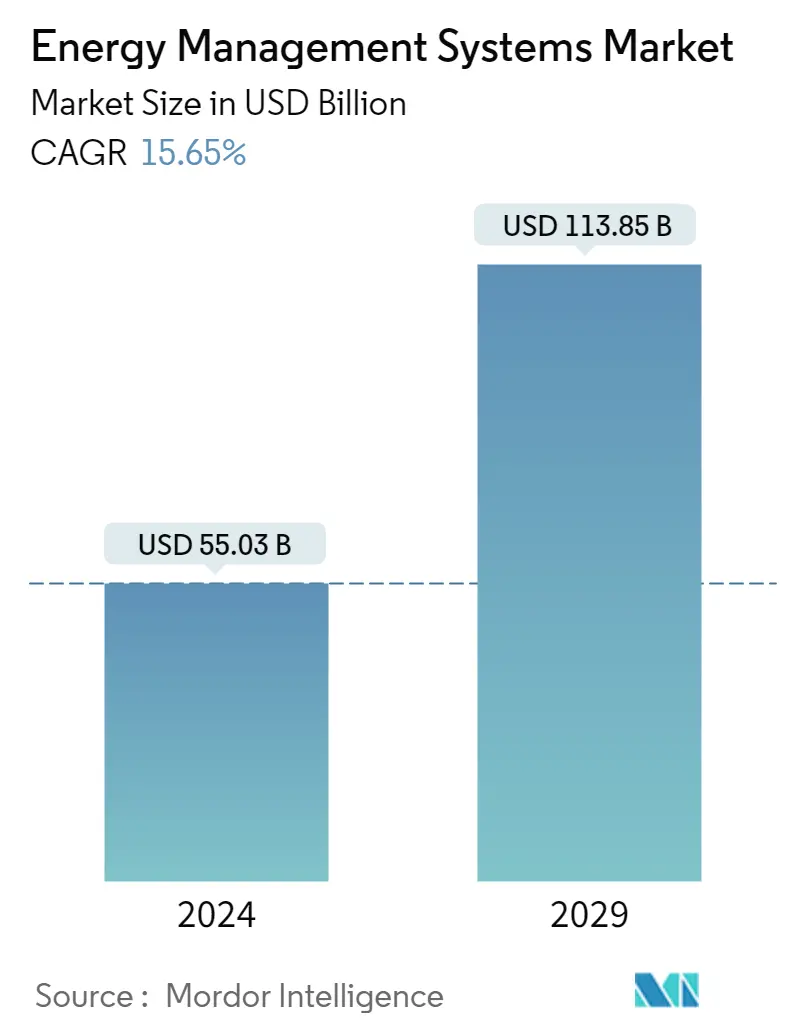Market Size of Energy Management Systems Industry

| Study Period | 2019 - 2029 |
| Market Size (2024) | USD 55.03 Billion |
| Market Size (2029) | USD 113.85 Billion |
| CAGR (2024 - 2029) | 15.65 % |
| Fastest Growing Market | Asia Pacific |
| Largest Market | Europe |
| Market Concentration | Low |
Major Players
*Disclaimer: Major Players sorted in no particular order |
Energy Management System Market Analysis
The Energy Management Systems Market size is estimated at USD 55.03 billion in 2024, and is expected to reach USD 113.85 billion by 2029, growing at a CAGR of 15.65% during the forecast period (2024-2029).
Due to the growing demand for multiple Smart Meter applications by end users, as well as investments in intelligent electric and building technologies, the market is expanding. In September 2022, the US (DOE) invested USD 10.5 billion to strengthen the country's energy grid through smart grids and other upgrades. The financing was consolidated into the Grid Resilience and Innovation Partnership program, divided into USD 2.5 billion for grid resilience, USD 3 billion for smart grids, and USD 5 billion for grid innovation.
- Technological developments, like network communications, are rapidly improving. Bidirectional communication mediums, smart grids, information infrastructures, power conservation methodologies, and various strategies, home area networks are experiencing a revolutionary change in multiple areas of power consumption domains, like electricity usage patterns and energy conservation at consumption premises. In February 2023, Enphase Energy, Inc., a global energy technology company and the world's largest manufacturer of microinverter solar arrays and batteries, announced that it began supplying IQ Batteries to Austrian customers in order to extend their availability throughout Europe.
- According to Exxon Mobile, energy demand is anticipated to increase across the industrial sector by 2040, accounting for 123 quadrillion British thermal units, pushing the need for EMS solutions. Energy efficiency has increasingly evolved as the primary focus of private companies and government authorities worldwide. The increasing economic activities have led to high energy consumption rates and have pushed the international electricity grids to their limits.
- Due to government regulations, cost savings, and energy consumption optimization, homes, industries, and enterprises have increasingly adopted energy management solutions. Costs are reduced by the primary component of EMS measurement, communication, and software applications. Building wastes at least 30% of their energy, according to a study done by MIT, which could be avoided through EMS. Further, in January 2023, the French government launched a unique support scheme for R&D projects centered on advanced 5G, 6G, and future generations of networks. Specifically, it is focused on solutions linked to virtualization, open interfaces on access networks, security, edge computing, and the integration of AI and ML. Such initiatives further expand the scope of the market.
- Significant vendors continuously invest in the studied market growth, including Schneider Electric, Honeywell International Inc., Panasonic Corporation, and Green Energy Options Limited. For instance, in November 2022, Schneider Electric company also confirmed that, in addition to its complete range of energy management products for the home, Wiser Gateways and Smart Plugs are some of the earliest products that have been certified by Matter.
- Energy management systems have advanced with technological developments by incorporating smart meters, smart sensors, and other devices. Installing the entire system is expensive, as it integrates various technologies to maintain energy efficiency. This poses a challenge to the market's growth.
Energy Management System Industry Segmentation
An energy management system (EMS) is a tool for monitoring, analyzing, and optimizing the operation of the electric transmission system. The system is widely used in various industries, and EMS implementation includes SCADA, Automatic Generation Control (AGC), and alarms, among others. The studied market is segmented by types of EMS, such as BEMS, IEMS, and HEMS, among various end-user industries such as manufacturing, power and energy, it and telecommunication, healthcare, residential and commercial in various applications such as energy generation, energy transmission, and energy monitoring.
The energy management system is categorized by segmentation type of EMS (BEMS, IEMS, and HEMS), end user (manufacturing, power & energy, IT& telecommunication, healthcare, and residential and commercial), application (energy generation, energy transmission, and energy monitoring), component (hardware, software, and services), and geography (North America, Europe, Asia-Pacific, Latin America, and the Middle East and Africa).
The market sizes and predictions are provided in terms of value in USD for all the above segments.
| By Type of EMS | |
| BEMS | |
| IEMS | |
| HEMS |
| By End User | |
| Manufacturing | |
| Power and Energy | |
| IT and Telecommunication | |
| Healthcare | |
| Residential and Commercial | |
| Other End Users |
| By Application | |
| Energy Generation | |
| Energy Transmission | |
| Energy Monitoring |
| By Component | |
| Hardware | |
| Software | |
| Services |
| By Geography*** | |||||||
| |||||||
| |||||||
| |||||||
| |||||||
|
Energy Management Systems Market Size Summary
The Energy Management System (EMS) market is experiencing significant growth, driven by the increasing demand for smart meter applications and investments in intelligent electric and building technologies. This expansion is further supported by government initiatives and funding aimed at enhancing energy grid resilience and innovation. Technological advancements in network communications, smart grids, and power conservation methodologies are revolutionizing energy consumption patterns and conservation efforts. The market is also witnessing a surge in adoption due to the focus on energy efficiency by both private companies and government authorities, as well as the rising energy consumption rates linked to economic activities. These factors are collectively propelling the demand for EMS solutions across various sectors, including homes, industries, and enterprises.
Global investments in energy-efficient infrastructure are on the rise, with Europe leading in such initiatives. Governments are increasingly adopting renewable energy solutions and enhancing power grid efficiency to meet regulatory requirements and reduce carbon footprints. The market is characterized by competitive dynamics, with major players like IBM, Rockwell Automation, and Schneider Electric investing in new technologies and partnerships to gain a competitive edge. Despite the high costs associated with implementing comprehensive EMS solutions, the market is poised for growth, supported by advancements in smart meters, sensors, and other devices. The ongoing development of smart cities and energy-efficient buildings, particularly in the UK and Germany, further underscores the market's potential as countries strive for energy efficiency and sustainability.
Energy Management Systems Market Size - Table of Contents
-
1. MARKET INSIGHTS
-
1.1 Market Overview
-
1.2 Industry Attractiveness - Porter's Five Forces Analysis
-
1.2.1 Bargaining Power of Suppliers
-
1.2.2 Bargaining Power of Buyers
-
1.2.3 Threat of New Entrants
-
1.2.4 Threat of Substitutes
-
1.2.5 Intensity of Competitive Rivalry
-
-
1.3 Impact of Macroeconomic Trends on the Market
-
-
2. MARKET SEGMENTATION
-
2.1 By Type of EMS
-
2.1.1 BEMS
-
2.1.2 IEMS
-
2.1.3 HEMS
-
-
2.2 By End User
-
2.2.1 Manufacturing
-
2.2.2 Power and Energy
-
2.2.3 IT and Telecommunication
-
2.2.4 Healthcare
-
2.2.5 Residential and Commercial
-
2.2.6 Other End Users
-
-
2.3 By Application
-
2.3.1 Energy Generation
-
2.3.2 Energy Transmission
-
2.3.3 Energy Monitoring
-
-
2.4 By Component
-
2.4.1 Hardware
-
2.4.2 Software
-
2.4.3 Services
-
-
2.5 By Geography***
-
2.5.1 North America
-
2.5.1.1 United States
-
2.5.1.2 Canada
-
-
2.5.2 Europe
-
2.5.2.1 United Kingdom
-
2.5.2.2 Germany
-
2.5.2.3 France
-
2.5.2.4 Spain
-
-
2.5.3 Asia
-
2.5.3.1 China
-
2.5.3.2 India
-
2.5.3.3 Japan
-
2.5.3.4 South Korea
-
2.5.3.5 Australia and New Zealand
-
-
2.5.4 Latin America
-
2.5.4.1 Brazil
-
2.5.4.2 Argentina
-
2.5.4.3 Mexico
-
-
2.5.5 Middle East and Africa
-
2.5.5.1 United Arab Emirates
-
2.5.5.2 Saudi Arabia
-
2.5.5.3 South Africa
-
-
-
Energy Management Systems Market Size FAQs
How big is the Energy Management Systems Market?
The Energy Management Systems Market size is expected to reach USD 55.03 billion in 2024 and grow at a CAGR of 15.65% to reach USD 113.85 billion by 2029.
What is the current Energy Management Systems Market size?
In 2024, the Energy Management Systems Market size is expected to reach USD 55.03 billion.

